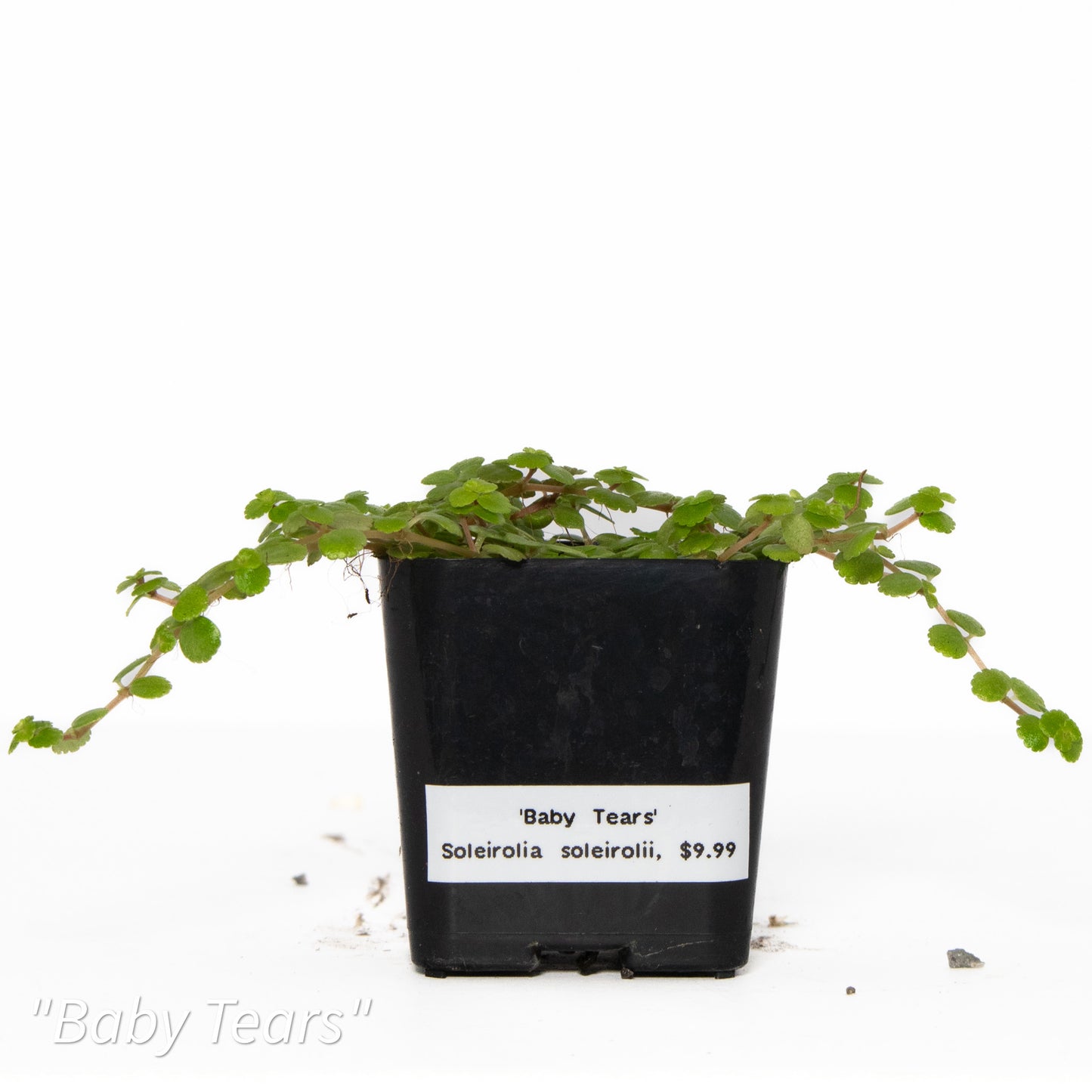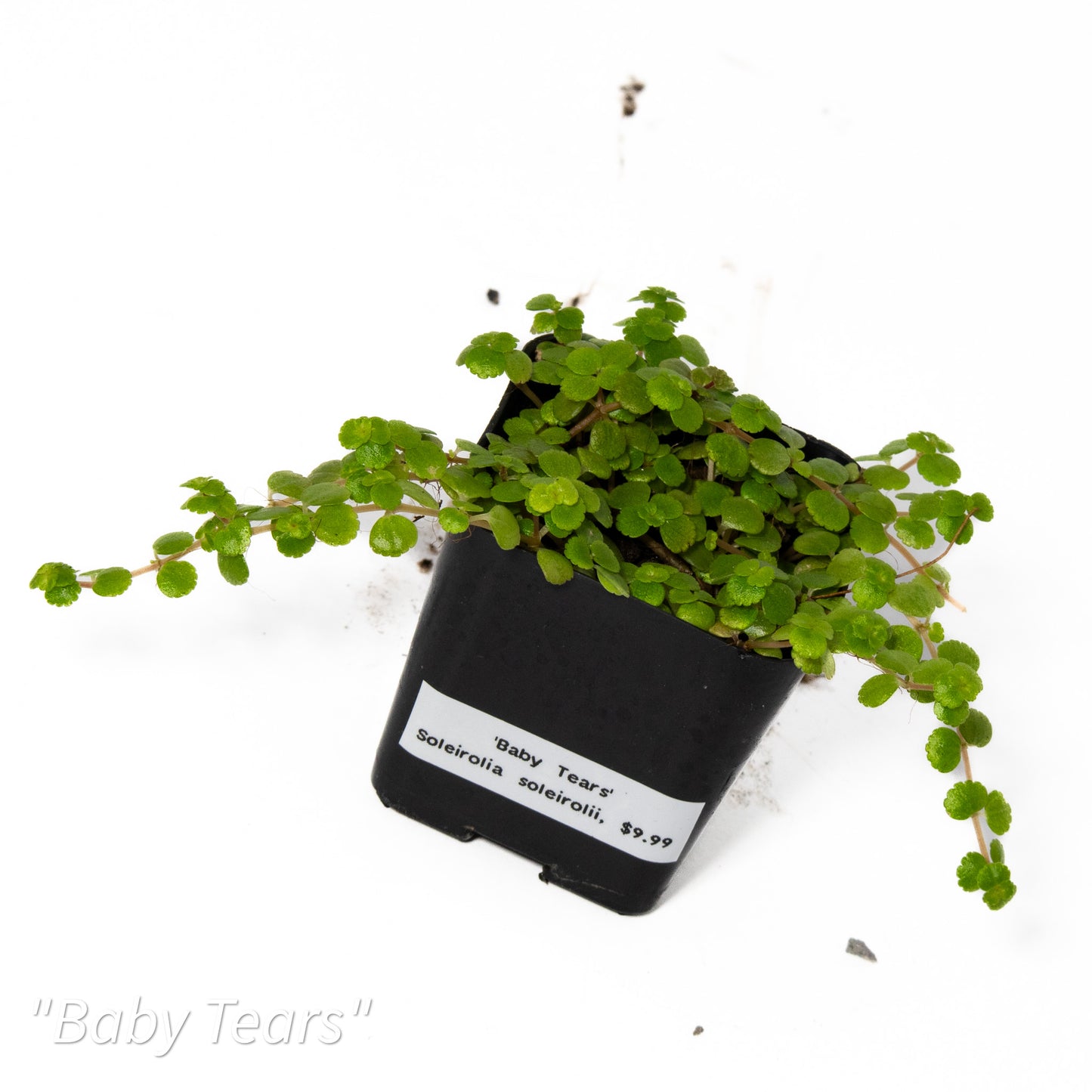Royal Python's Cove
Soleirolia soleirolii ‘Baby Tears’
Soleirolia soleirolii ‘Baby Tears’
Couldn't load pickup availability
Soleirolia soleirolii, commonly known as Baby Tears, is a delicate, creeping groundcover plant that forms a lush, green carpet of tiny, rounded leaves. Native to the Mediterranean, it is a fantastic choice for bioactive setups, where its dense growth and fine texture complement the natural habitat of vivariums or terrariums.
Care Instructions
LIGHT. Prefers bright, indirect light, but it can tolerate some low light conditions. The leaves may become more sparse and elongated in lower light levels, so for optimal growth and appearance, provide it with plenty of indirect sunlight. Avoid placing it in direct sunlight, as this can scorch its delicate leaves. In bioactive setups, position the plant near a light source, but shield it from harsh, direct rays to maintain its lush foliage.
SOIL. Requires a well-draining, moist soil mix to thrive. A blend of coconut coir, peat moss, and perlite works well, offering the moisture retention it needs without becoming waterlogged. In bioactive environments, this soil mix can help retain moisture while still providing good drainage, which is essential to avoid root rot.
WATERING. Keep the soil consistently moist, but avoid overwatering. Baby Tears thrives in humid environments, so ensure the substrate stays lightly damp but not soggy. Allow the top inch of soil to dry slightly before watering again. In bioactive setups, the isopods and springtails will help break down organic material, reducing the risk of excess moisture, while maintaining balance in the soil.
HUMIDITY. Thrives in high humidity levels, making it perfect for bioactive setups. Keep humidity levels above 60% for optimal growth. The humid environment of vivariums or terrariums is ideal for Baby Tears, encouraging dense and vibrant foliage. Regular misting or a shallow water dish can help maintain the necessary moisture levels in the air.
TEMPERATURE. Prefers moderate temperatures between 60°F and 75°F (16°C to 24°C). Avoid exposing it to temperatures below 50°F (10°C), as it may cause damage. In bioactive setups, ensure that the plant is kept in a warm, stable environment to maintain healthy growth.
FERTILIZATION. Feed with a diluted, balanced liquid fertilizer once a month during the growing season (spring and summer). Reduce fertilization in fall and winter when the plant’s growth slows down. In bioactive setups, decomposers like springtails and isopods help create a nutrient-rich substrate, which may reduce the need for frequent fertilization.
Cohabitation with Bioactive Organisms
ISOPODS. Isopods are beneficial companions for Baby Tears, as they help break down decaying organic matter and keep the soil healthy. The fine foliage of Baby Tears provides a natural shelter for isopods, and in return, they help maintain the soil structure, preventing compaction and promoting healthy root growth.
SPRINGTAILS. Springtails thrive in the moist, humid conditions that Baby Tears loves. These tiny creatures feed on mold and decaying organic material, helping to keep the substrate clean and free from fungal growth. They contribute to a balanced, healthy ecosystem in the bioactive setup by preventing mold from damaging the plant.
Soil and Maintenance Tips
SUBSTRATE. A light, moisture-retentive mix works best for Soleirolia soleirolii. A combination of coconut coir, peat moss, and perlite allows for proper moisture retention while ensuring adequate drainage to avoid waterlogging. Adding a small layer of activated charcoal can help with odor control and improve overall soil health.
HUMIDITY CONTROL. To maintain the high humidity that Baby Tears thrives in, consider using a shallow water dish, misting regularly, or even integrating a humidifier in your bioactive setup. Since Baby Tears does well in damp environments, make sure the substrate doesn’t dry out too quickly, and maintain consistent humidity levels.
TRIMMING. Baby Tears grows rapidly and can spread quickly, so regular trimming helps prevent it from becoming too invasive in its container or bioactive environment. Cut back any long or unruly stems to encourage bushier growth and maintain its compact form. You can propagate this plant easily by cutting stems and replanting them in moist soil or water.
PEST CONTROL. Baby Tears is generally pest-resistant, but in bioactive setups, springtails and isopods can help keep any potential pest populations under control by consuming pest eggs or larvae. Regularly inspect for mealybugs or aphids, which can occasionally target new growth.
With its delicate, lush foliage and ease of care, Soleirolia soleirolii ‘Baby Tears’ is a beautiful and functional addition to any bioactive setup. Its dense mat of tiny leaves creates a soft, carpet-like effect, while its compatibility with other decomposers ensures a thriving and sustainable environment for both the plant and the ecosystem. By mimicking its natural habitat with proper humidity, light, and soil, you’ll help this plant flourish in your vivarium or terrarium.
Share




